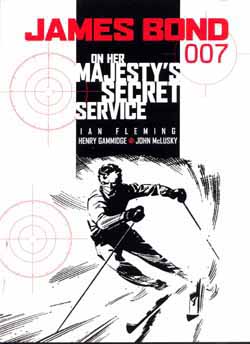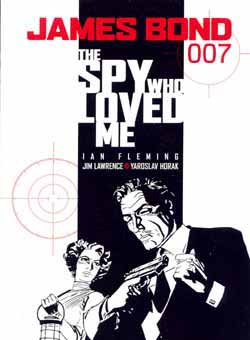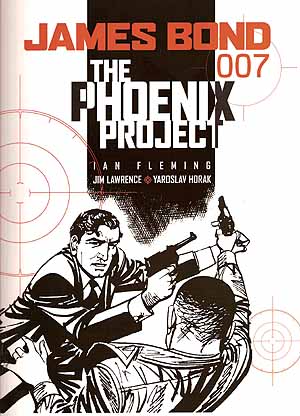 Â
Â
By Ian Fleming and Various (Titan Books)
ISBN 1-84023-674-4
There are sadly very few British newspaper strips that can rival the influence and impact of the classic daily and Sunday “funnies†from America, especially in the field of adventure fiction. The 1930’s and 1940’s were particularly rich in popular, not to say iconic, creations. You would be hard-pressed to come up with household names to rival Popeye, Dick Tracy, Buck Rogers, The Phantom, Mandrake the Magician, Flash Gordon or Steve Canyon, let alone Terry and the Pirates or the likes of Little Lulu, Blondie, Li’l Abner, Little Orphan Annie or Popeye and yes, I know I said him twice, but Elzie Segars’s Thimble Theatre was funny as well as thrilling, constantly innovative, and really, really good.
What can you recall for simple popularity let alone longevity or quality in Britain? Rupert Bear? Absolutely. Giles? Technically, yes. Nipper? Jane? Garth? I hope so, but I doubt it. The Empire didn’t quite get it until it wasn’t an empire any more. There were certainly many wonderful strips being produced: well-written, beautifully drawn, but that stubborn British reserve just didn’t seem to be in the business of creating household names. Until the 1950’s.
Something happened in the ‘fifties in Britain – and I’m not going to waste any space here discussing it. It just did. Now we’re moving on. In a new spirit that seemed to crave excitement and accept the previously disregarded, comics got carried along on the wave. Eagle, the regenerated Beano, girls’ comics in general, all shifted into high gear, and so did newspapers. And that means that I can go on about a graphic collection with proven crossover appeal for a change.
The first 007 novel – Casino Royale -was published in 1953 and was serialised in the Daily Express from 1958, beginning a run of book adaptations (by Anthony Hern, Henry Gammidge, Peter O’Donnell and Kingsley Amis) before Jim Lawrence, a jobbing writer who had scripted the aforementioned Buck Rogers, came aboard with The Man With The Golden Gun to complete the transfer of the Fleming canon to strip format, thereafter being invited to create all new adventures, which he did until the strip’s demise in 1983.
The art on the strip was always of the highest standard. John McLusky provided the illustration until 1966 and the conclusion of You Only Live Twice. Although perhaps lacking in verve, the workmanlike clarity of his drawing easily handled the immense variety of locales, technical set-ups and sheer immensity of cast members, whilst accomplishing the then novel conceit of advancing a plot and ending each episode on a cliff-hanging “hook†every day. He was succeeded by Yaroslav Horak, who also debuted on Golden Gun with a looser, edgier style, at once more cinematic and with a closer attention to camera angle and frenzied action that seemed to typify the high-octane 1960’s.
What’s in this volume? Possibly the two best novels adapted back to back. After a falling out with the Express‘ owner, the Bond strip was missing from the paper’s pages from February 1962 until June 1964. The gap was explained as Bond’s year long search for arch villain Blofeld. On Her Majesty’s Secret Service has the agent finally discover his enemy and his perfect woman in a high-octane action extravaganza in the Swiss Alps. Closely adhering to Fleming’s script – as did the George Lazenby film version – the adventure ends with the wedding day murder of Bond’s bride, an atypically downbeat conclusion that directly leads into You Only Live Twice.
Eight months after the death of his wife, a broken Bond is called back from compassionate leave for a routine mission to Japan. Both he and ‘M’ know that this will be a make-or-break job for the demoralised super-agent. Initially indifferent, Bond warms not only to the culture but the characters of Japan, and when circumstances alter the mission into one of ultimate revenge, Bond is back with a vengeance!
Titan Books is re-releasing collected editions of these classic strips after an abortive first attempt in the 1980s. The utterly minor niggle that they’re not coming out in chronological order (I’m a fanboy too, so sue me) is easily countered by the informative checklist in each volume; and these are superb examples of the best of British – even if Lawrence is a damn Yankee and Horak an Ozzie by way of Manchuria. Get them all and sort it all out in a big leather chair over a Vodka Martini. You know the way it should be served… and by the time you read this it won’t matter anyway, so just remember your instructions. Buy them all!
Strip © Express Newspapers Ltd. 1987. All Rights Reserved.

 Â
 